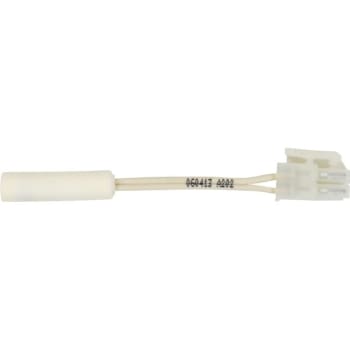The thermistor on a Frigidaire refrigerator is located in the freezer section. It is generally found near the evaporator coil.
The thermistor plays a crucial role in regulating the temperature inside the refrigerator by sensing the air temperature and sending signals to the control board. It is a small sensor that measures the temperature and helps the refrigerator maintain the desired cooling level.
If there are temperature-related issues with your Frigidaire refrigerator, such as fluctuating temperatures or ice buildup, the thermistor could be a potential culprit. Identifying its location can help you troubleshoot problems and replace the faulty thermistor if needed.
By understanding the thermistor’s role and position, you can ensure your Frigidaire refrigerator functions efficiently and keeps your food fresh for longer.
Importance Of The Thermistor
The thermistor is a crucial component in your Frigidaire refrigerator that plays a vital role in maintaining optimal temperature control. As a small but powerful sensor, the thermistor helps regulate the cooling system, ensuring your fridge maintains consistent and safe temperature levels. Understanding the role and importance of the thermistor is essential for troubleshooting and keeping your refrigerator running smoothly.
Role Of The Thermistor In A Frigidaire Refrigerator
In a Frigidaire refrigerator, the thermistor serves as the temperature sensor. It measures the air temperature inside the fridge and relays this information to the control board. The control board then adjusts the cooling system accordingly to maintain the desired temperature. The thermistor acts as a feedback device, constantly monitoring the temperature and providing valuable data to the refrigerator’s control system.
Importance Of The Thermistor In Maintaining Temperature Control
Temperature control is vital in refrigerators to ensure food safety and preservation. The thermistor helps achieve this by accurately monitoring the temperature and allowing the control board to make necessary adjustments. Without a properly functioning thermistor, your refrigerator could experience temperature fluctuations that may lead to spoilage or freezing of food items.
By sensing any temperature deviations from the set target, the thermistor prompts the control board to activate the cooling system or defrost cycle, helping to maintain a stable temperature inside the fridge. This precise temperature control reduces energy consumption, prevents excessive ice buildup, and facilitates optimal food storage conditions.

Credit: hdsupplysolutions.com
Understanding The Thermistor
In a Frigidaire refrigerator, the thermistor plays a vital role in maintaining the optimal temperature inside the appliance. Understanding what a thermistor is and how it functions can help you troubleshoot temperature-related issues and ensure the smooth operation of your refrigerator.
Explanation Of What A Thermistor Is
A thermistor is a temperature-sensing device that measures and regulates temperature within a specific range. It consists of a resistor made from semiconductor material with electrical resistance that varies with temperature changes. The word ‘thermistor’ is derived from the combination of ‘thermal’ and ‘resistor.’
The resistance of a thermistor decreases as temperature rises, allowing it to control the refrigerator’s cooling system. By monitoring the temperature, the thermistor provides feedback to the refrigerator’s control board, enabling it to adjust cooling cycles accordingly.
How The Thermistor Works In A Refrigerator
The thermistor in a Frigidaire refrigerator is typically located near the evaporator coil, which is responsible for cooling the air inside the appliance. It measures the temperature in this area and sends the information to the control board. This data enables the control board to determine whether the cooling cycle needs adjustment to maintain the desired temperature.
When the refrigerator’s compressor starts, the evaporator fan draws air over the evaporator coil, which cools the air. The thermistor measures the temperature of this cooled air before it is circulated throughout the refrigerator to keep the stored food fresh. If the temperature deviates from the set point, the thermistor triggers the control board to adjust the cooling cycles accordingly, optimizing energy efficiency and preserving the quality of the stored food.
Different Types Of Thermistors Used In Frigidaire Refrigerators
Frigidaire refrigerators use different types of thermistors, depending on the model and specific temperature-sensing requirements. The two most commonly used thermistors in Frigidaire refrigerators are:
| Thermistor Type | Function |
| NTC Thermistors | Negative Temperature Coefficient (NTC) thermistors are the most common type used in Frigidaire refrigerators. These thermistors have a higher resistance at lower temperatures and lower resistance at higher temperatures, allowing for accurate temperature sensing. |
| PTC Thermistors | Positive Temperature Coefficient (PTC) thermistors have a resistance that increases with rising temperature. In some Frigidaire refrigerator models, PTC thermistors are used for specific temperature regulation purposes, such as defrost cycle control. |
These different types of thermistors ensure precise temperature monitoring and control throughout the refrigerator, ensuring optimal performance and food preservation.
Locating The Thermistor In A Frigidaire Refrigerator
If you are experiencing issues with your Frigidaire refrigerator, such as improper cooling or temperature fluctuations, it might be time to check the thermistor. The thermistor is a vital component that helps regulate the temperature inside the refrigerator.
Common Placement Of The Thermistor In Frigidaire Refrigerators
The thermistor in Frigidaire refrigerators is typically located near the evaporator coil, which is responsible for cooling the air inside the fridge. The exact placement may vary depending on the specific model and make of your refrigerator. However, you can generally find the thermistor in one of the following common positions:
- Clip-on thermistor attached to the evaporator coil: In some Frigidaire refrigerator models, the thermistor is clipped onto the evaporator coil. This placement ensures that the temperature readings are accurate and responsive to changes in the cooling process.
- In-line thermistor within the air duct: Another common placement is installing the thermistor within the air duct. This position allows the thermistor to monitor the temperature of the air that circulates within the refrigerator compartment.
- Mounted thermistor on the refrigerator wall: Frigidaire refrigerators may also have the thermistor mounted on the inner wall of the refrigerator. This placement allows the thermistor to monitor the overall temperature inside the fridge.
Step-by-step Guide To Locating The Thermistor
To locate the thermistor in your Frigidaire refrigerator, follow these steps:
- Unplug the refrigerator and ensure it is safely disconnected from the power source.
- Remove any food items from the refrigerator and clear the shelves to create space for easy access.
- Carefully remove the inner rear wall panel of the refrigerator. Remember to check your refrigerator’s manual for specific instructions on removing the panel, as it may vary based on the refrigerator model.
- Inspect the area behind the rear wall panel for the presence of the thermistor. Look for a small sensor with a wire attached to it.
- If you are having trouble locating the thermistor, consult your refrigerator’s manual or contact Frigidaire customer support for further guidance.
Potential Challenges In Locating The Thermistor
While locating the thermistor in your Frigidaire refrigerator may seem straightforward, there are a few challenges you might encounter:
- Hidden placement: In some models, the thermistor might be concealed behind other components or within a harness. Take your time and carefully explore the area behind the rear wall panel.
- Variations in model placement: Frigidaire refrigerators come in various models and designs, which can result in differences in thermistor placement. Make sure to refer to your refrigerator’s manual for accurate information.
- Complexity of disassembling: Removing the rear wall panel can be intimidating, especially if you are not familiar with appliance repairs. If you are hesitant or unsure, it is recommended to seek professional assistance to avoid any damage or injury.
Troubleshooting The Thermistor
When it comes to maintaining the ideal temperature in your Frigidaire refrigerator, one crucial component to keep an eye on is the thermistor. The thermistor is responsible for sensing the temperature inside the refrigerator and sending signals to the control board. However, like any other electronic component, the thermistor can develop faults over time.
In this section, we will explore the signs of a faulty thermistor, the steps to test its functionality, and common issues with their respective solutions.
Signs Of A Faulty Thermistor In A Frigidaire Refrigerator
A faulty thermistor can lead to temperature inconsistencies and potential food spoilage in your Frigidaire refrigerator. It’s important to recognize the signs of a faulty thermistor to address the issue promptly. Here are some symptoms that indicate a problem with the thermistor:
- Unusually high or low temperatures inside the refrigerator
- Frequent and unexpected fluctuations in temperature
- Frost buildup in the freezer compartment despite proper defrosting
- Food spoils quickly even when stored at the correct temperature
- The refrigerator not cooling efficiently or taking longer to reach the desired temperature
Steps To Test The Thermistor For Functionality
If you suspect that your Frigidaire refrigerator’s thermistor is causing issues, you can perform a simple test to check its functionality. Follow these steps:
- Unplug the refrigerator: Before performing any tests, ensure that the refrigerator is unplugged to eliminate the risk of electrical shock.
- Locate the thermistor: The thermistor is typically found inside the refrigerator compartment, attached to the evaporator or near the air diffuser.
- Remove the thermistor: Gently detach the thermistor from its housing or connector. Refer to your refrigerator’s manual for specific instructions on how to safely remove the thermistor.
- Use a multimeter: Set your multimeter to the resistance or ohms setting and connect the probes to the thermistor’s terminals. Check the resistance reading displayed on the multimeter.
- Compare the reading: Compare the resistance reading you obtained with the ideal resistance specified in your refrigerator’s manual. If the reading falls significantly outside the recommended range, it indicates a faulty thermistor.
Common Issues And Solutions Related To The Thermistor
Now that you know how to test the thermistor for functionality, it’s essential to understand the common issues that may arise with this component and their respective solutions. Here are some problems you may encounter:
| Issue | Solution |
| The thermistor reading consistently too high or too low | Replace the faulty thermistor with a new one that matches the manufacturer’s specifications. |
| Incorrect temperature displayed on the control panel | Reset the control board or replace it if necessary. Ensure that the thermistor is properly connected to the new control board. |
| Refrigerator not defrosting as it should | Check the defrost heater, defrost thermostat, and defrost timer for faults. If all other components are functioning correctly, replacing the thermistor might solve the issue. |
By troubleshooting and addressing any issues with your Frigidaire refrigerator’s thermistor, you can ensure that it continues to operate at optimal temperature levels, keeping your food fresh and safe. Regularly checking the thermistor’s functionality is a proactive approach to avoid costly repairs or potential food wastage.
Importance Of Maintaining The Thermistor
The thermistor in a Frigidaire refrigerator is a crucial component that plays a significant role in ensuring the unit operates efficiently. It is responsible for monitoring the temperature inside the refrigerator and sending signals to the control board to regulate the cooling system. Without proper maintenance, the thermistor can become faulty or ineffective, leading to potential issues with the refrigerator’s functionality.
Regular Maintenance For Optimal Thermistor Performance
Regular maintenance is essential to keep the thermistor in top condition and ensure it functions optimally. Here are a few tips to help you maintain the thermistor:
- Periodically check the thermistor for any signs of damage or wear. Inspect the wires and connections to make sure they are intact.
- Clean the area around the thermistor to prevent the accumulation of dirt, dust, and debris. This can interfere with its temperature-sensing capabilities.
- Ensure that the thermistor is properly positioned and securely attached. Any loose connections can result in inaccurate temperature readings.
- Consult the refrigerator’s user manual for specific maintenance instructions provided by the manufacturer. Following these guidelines can help you maintain the thermistor effectively.
Tips For Cleaning And Caring For The Thermistor
Cleaning and caring for the thermistor is a straightforward process that can significantly contribute to its longevity and accurate functionality. Here are a few tips to help you with this:
- Use a soft cloth or cotton swab to gently clean the thermistor. Avoid using abrasive materials or cleaners, as these can damage the delicate sensor.
- If you encounter stubborn dirt or residue, moisten the cloth or cotton swab with a mild detergent solution and carefully clean the thermistor.
- Always ensure that the thermistor is completely dry before reattaching it or turning on the refrigerator. Moisture can interfere with its performance and potentially cause damage.
- Regularly inspect the surrounding area to ensure there is no moisture or water leakage that could affect the thermistor’s functionality. Fix any leaks promptly to prevent further issues.
How A Faulty Thermistor Affects The Refrigerator’s Functionality
A faulty thermistor can have various detrimental effects on the refrigerator’s overall performance. Some common issues caused by a malfunctioning thermistor include:
- Inconsistent cooling or temperature fluctuations, leading to food spoilage.
- The refrigerator running continuously or not cooling properly.
- Freezer temperature is too high or too low.
- Excessive frost build-up in the freezer compartment.
It is essential to address any problems with the thermistor promptly to avoid further complications and ensure the refrigerator operates at its best.
Frequently Asked Questions On Where Is The Thermistor On A Frigidaire Refrigerator
Where Is The Thermistor Located In A Frigidaire Refrigerator?
The thermistor in a Frigidaire refrigerator is typically located near the evaporator coils. It is a small sensor that monitors the temperature inside the fridge and sends signals to the control board. Its precise location may vary depending on the model and design of the refrigerator.
Why Is The Thermistor Important In A Frigidaire Refrigerator?
The thermistor plays a crucial role in maintaining the optimal temperature inside a Frigidaire refrigerator. It helps regulate the cooling cycle by monitoring the temperature and signaling the control board to turn the compressor on or off. This ensures efficient cooling and prevents issues like food spoilage or freezer burn.
How Does The Thermistor Affect The Performance Of A Frigidaire Refrigerator?
The thermistor directly impacts the performance of a Frigidaire refrigerator by providing accurate temperature readings. If the thermistor is faulty or malfunctions, the refrigerator may not cool properly or may run continuously, leading to energy inefficiency and potential damage to the compressor or other components.
Can I Replace The Thermistor In My Frigidaire Refrigerator Myself?
Yes, you can replace the thermistor in your Frigidaire refrigerator yourself. However, it is recommended to consult the appliance’s manual or seek professional assistance to ensure proper installation. Using the correct replacement part and following the manufacturer’s instructions will help avoid any potential issues or voiding the warranty.
Conclusion
To locate the thermistor on a Frigidaire refrigerator, you can refer to the user manual or seek professional assistance. The thermistor plays a crucial role in maintaining the optimal temperature inside the refrigerator, ensuring efficient cooling. By understanding its location and function, you can diagnose and troubleshoot any temperature-related issues with your Frigidaire refrigerator easily.
Keeping the thermistor clean and in good condition will help prolong the lifespan of your appliance and ensure its optimal performance. Stay informed and take proper care of your refrigerator to enjoy its benefits for years to come.
Hello Readers, I am Mechanic Shuvo, a seasoned refrigerator solution expert with over 11 years of hands-on experience in the field. Throughout my career, I've dedicated myself to understanding the ins and outs of refrigeration systems, honing my skills as a refrigerator mechanic. My passion for these appliances led me to create the website "refrigeratorsolutionsguide.com," where I aim to share my wealth of knowledge and expertise with others.
Over the years, I've encountered a wide range of refrigerator issues and have successfully resolved them all. From common problems like temperature fluctuations and strange noises to more complex technical issues, I've seen it all. Through my website, I hope to provide practical solutions, insightful tips, and guidance to help you keep your refrigerators running smoothly.







